More notes on designing a three foot vegetable bed
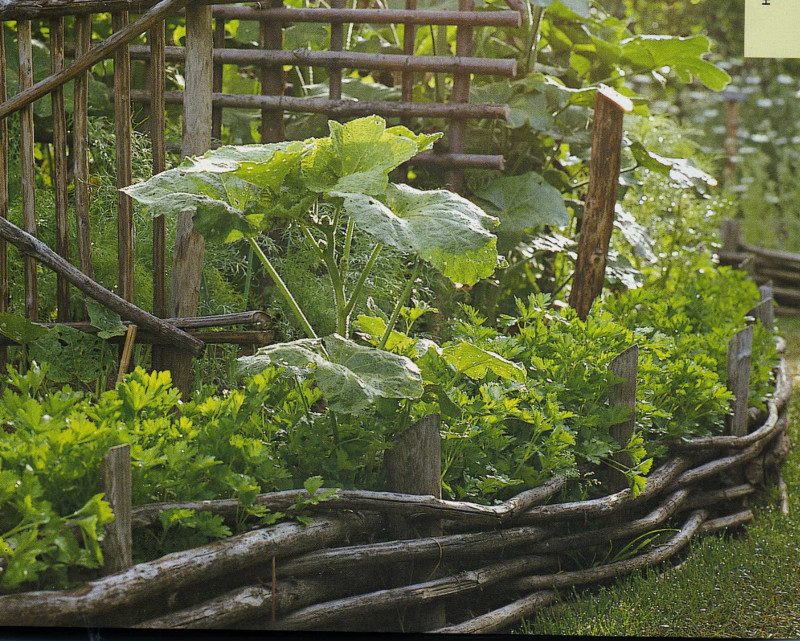 Plan B. Coy Karen has returned and there are dilemmas. I think it’s time to write a bit further about her garden design. If it’s too hard to click back a few pages, here is the layout challenge.
Plan B. Coy Karen has returned and there are dilemmas. I think it’s time to write a bit further about her garden design. If it’s too hard to click back a few pages, here is the layout challenge.
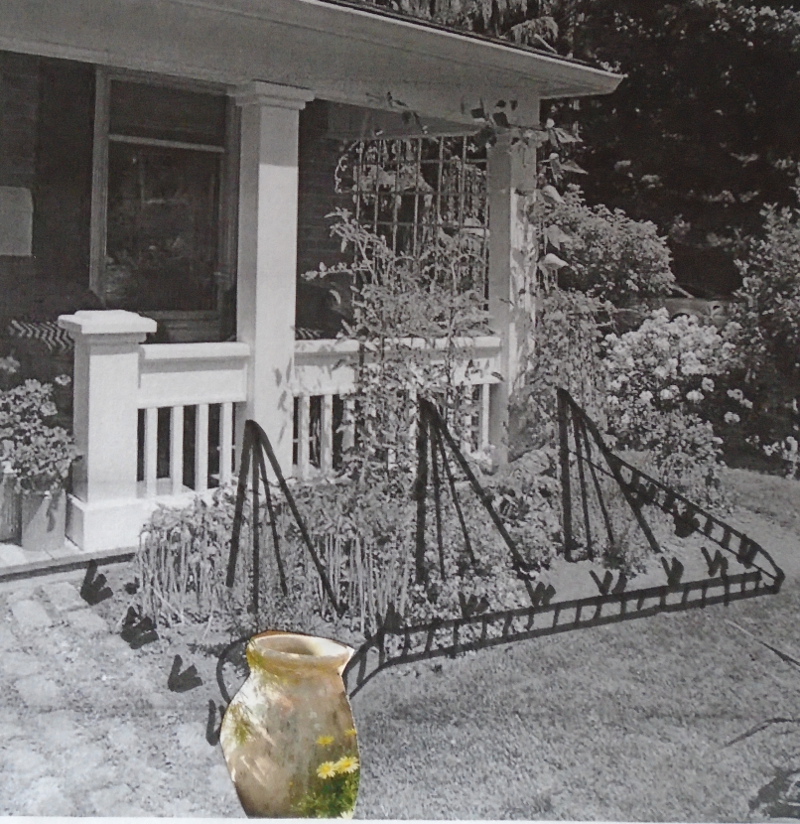 A house without symmetry, a desire for curved bed. The first design attempt was very linear. So let’s think wonky.
A house without symmetry, a desire for curved bed. The first design attempt was very linear. So let’s think wonky.
You can have a stab at low rustic barrier between the grass and the vegetable bed. (All my pictures are full size today which is playful. Good for the myopic among us.) This woven wooden panel is fun and simple. And you can see that the plants right behind are flowing over and through in some places.
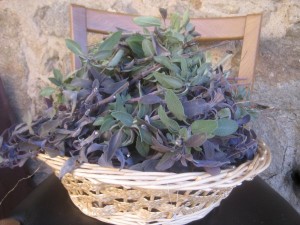 But I was thinking that there is a vegetable solution to this and I have two candidates. Thyme. And purple sage.
But I was thinking that there is a vegetable solution to this and I have two candidates. Thyme. And purple sage.
I design with a lot of purple sage in my garden because I am cheap. It is the easiest herb to reproduce. Every spring I cut it back and take hundreds of little woody cuttings (go back to March 7, 2015 and you will see how easy it is).
They root in a few weeks and within a month you have new plants. And at the right time of year. You could mass plant a little hedge at the beginning of May just when your soil has warmed up well and is ready for plants.
And they are brilliantly behaved sage plants. They do not flower. So you can expect them to stay in a neat dense shape. And as you can take so many cuttings, you can have the massed plant effect all the way around the border of your new bed. But don’t be spindly. 
Dense planting is fine. Let them fight it out.
The other plant you could use, but would be a bit more of an investment is thyme.
Here is an example of planting thyme as a barrier along a set of steps. And yes I inherited the crazy paving. Believe me, I would not have chosen glaring white crazy paving. It’s a bit like opting for COLOURED COMPOST.
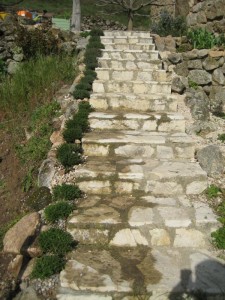 Sorry to shout. And spell with a U. But really? What is wrong with brown mulch?
Sorry to shout. And spell with a U. But really? What is wrong with brown mulch?
Back to the thyme. It is slower growing. So you would need a lot of plants if you were going to use them as a low hedging plant. And you do need to cut them back straight after flowering (and harvesting the aromatic leaves for drying).
But they form a fabulous barrier. You can see them in flower in the title picture.
So that might be the solution to the reluctant fence builder.
Or you could use a single layer of bricks. Very low and discreet. Or a few logs. My beds are all chestnut logs in the potager. But only because they are the product I have to hand. And are free. And how do you find curving ones? Maybe stick to vegetation.
I saw these obelisks at Waterperry Gardens in Oxfordshire which made me think of nice structures for this garden bed.
Sturdy but handsome. I still think that the only way to deal with space is symmetry. Even if the house isn’t.
And the problem (or as we say in gardening design, the challenge) of the tall tomatoes at the back.
Not a problem. Grow more! Grow them all the way along the back of the border. Or repeat them on the other side. But why not intersperse them with some distracting plants that can get almost as high.
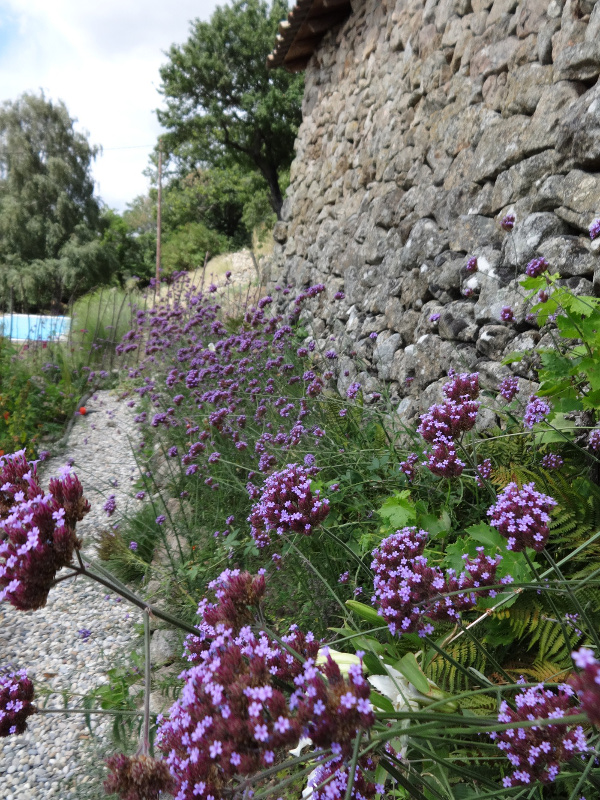 A brilliant plant in this situation might be verbena bonariensis. Verbena from Bueonos Aires.
A brilliant plant in this situation might be verbena bonariensis. Verbena from Bueonos Aires.
Yes, I know you are in Canada. But my garden has gone down to minus 18 Celsius (pause – find the website that does the conversion – -0.3999999999999986F) And gets snow.
If you plant this flower right at the back of the bed in an even row all the way next to the house your eye will feast on that, rather than the tomatoes. It is tall and stiff and doesn’t need much staking. 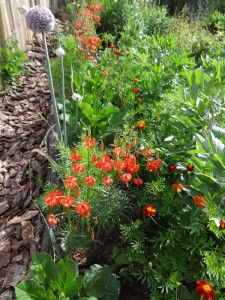
And why not add a row of leeks just in front? Leeks if left unharvested will throw up the most wacky tall flowers in their second year.
I’ve had a rummage in my potager picture folder and you can see them here in among the lilies. The best thing about leeks is they take up very little room. A useful feature in this narrow bed.
The pale mauve might not show up well against the white wood of the house behind. But that’s not a problem. Paint your house black. Or dark grey. All plants look better against this backdrop.
And now to the signature pots.
I still think it would be great to have two right beside the path and just where the plants in your low fence area begins.
Some look very formal – in this instance. But if you place your pot right up against the plants, it adds height that will be in perfect contrast to the immediate plants. But also relate to the tall tomatoes at the back.
Here they have made a barrier out of lavender. And planted good flowing nasturtiums over the edge of the pot.
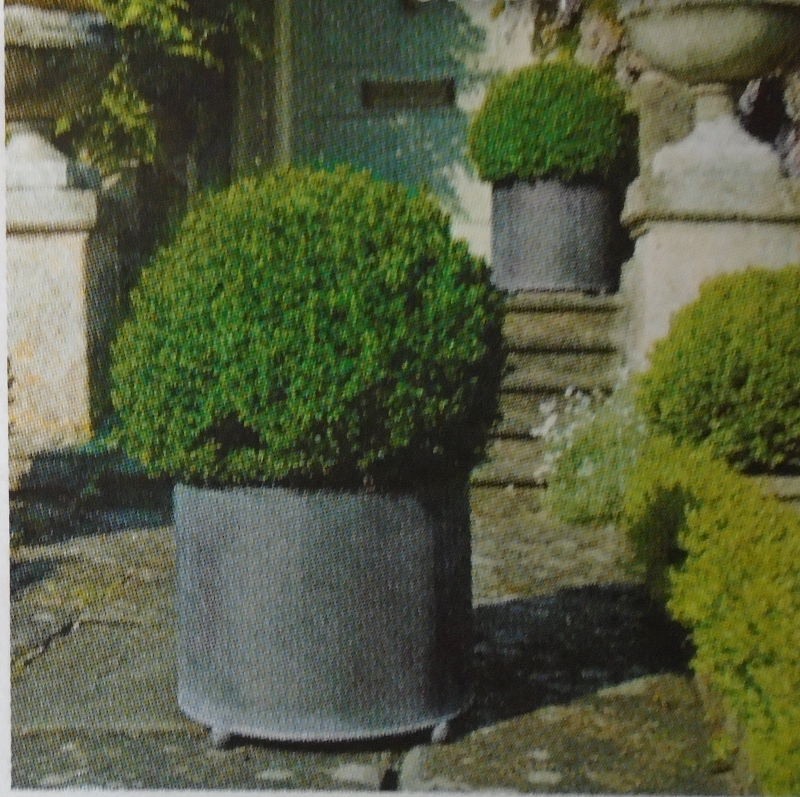
Planting densities for the swiss chard? Plant them closer than in your community garden. You want the jungly effect.
And if you do have a mulch problem. The solution is at hand. Sow nasturtium seeds and let them go mad. And let them self sow. Here is an example of one of my vegetable beds that has a perfect ground cover of colour. It will distract you from the fact my lettuce is bolting merrily away.
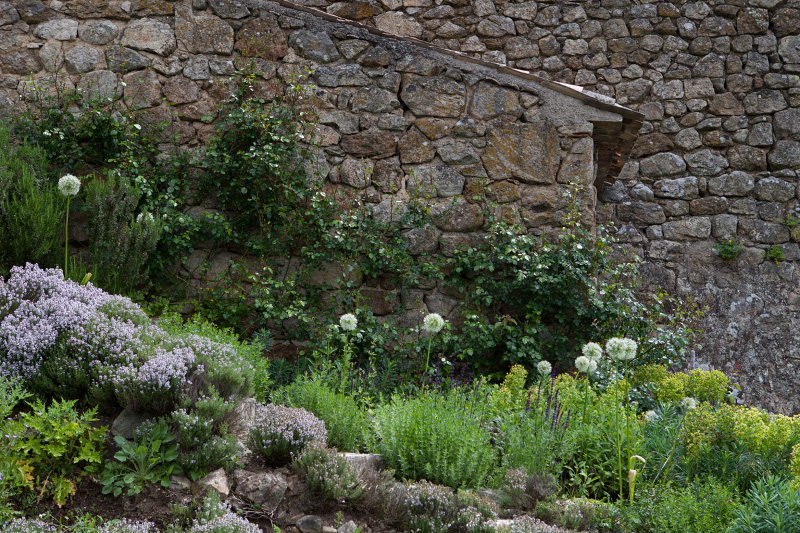
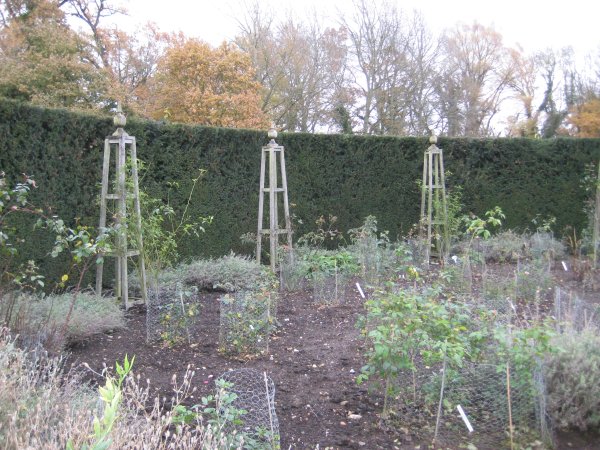
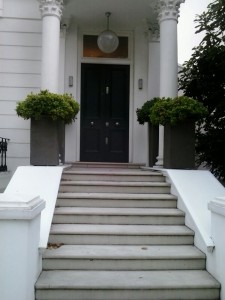
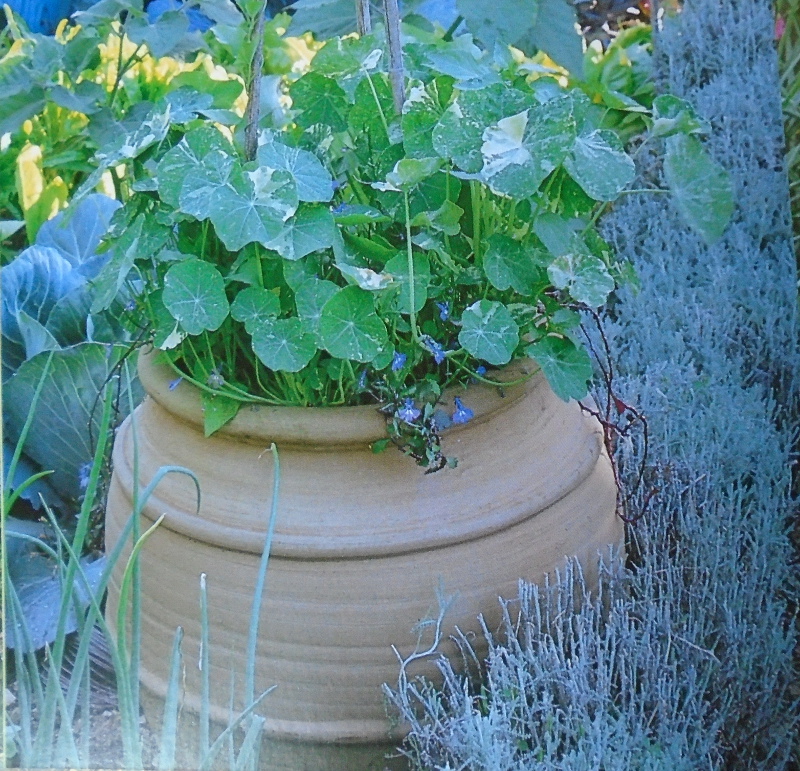
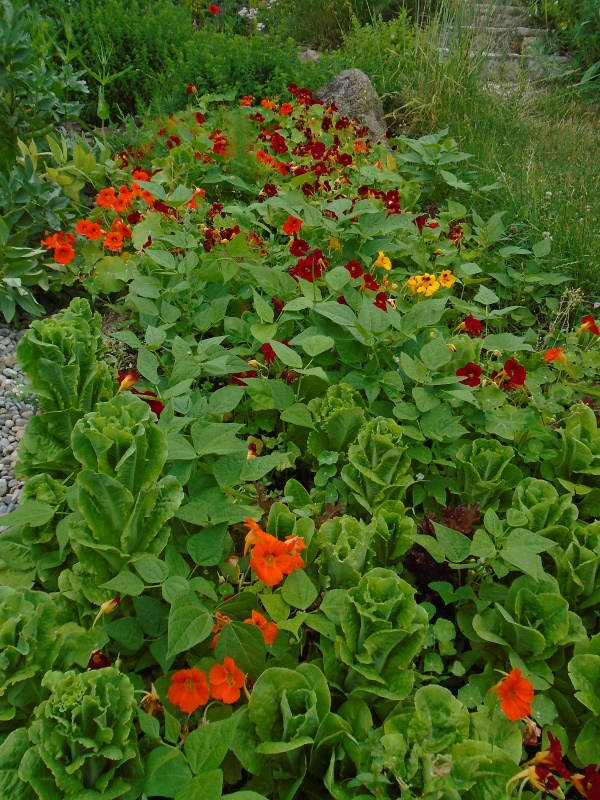
18th August 2015 @ 6:18 pm
You’re right, lol! I didn’t even notice the bolting lettuce. The guy next to me in the community garden has nasturtium, I’ll take a closer look at his. Plus I like that you can use the flowers in salad.
NOW I know what you mean by signature pot. They’re what I would call a statement pot or planter. LOVE the round ones, but I think the perfectly square ones would be good with my square posts. My porch is painted white but the actual house is red brick. Which I’ve considered painting, believe me, but it’s nice 170 year old, hand formed brick so I haven’t. I also love the obelisks and might make building them one of my winter projects.
If I give it a ridiculous amount of thought I might be able to think of a way I can have the front beds be squared off while maintaining a curved side. I absolutely LOVE the curved, woven logs but I don’t think I have it in me to do it, lol.
O.K. I think I’m good to go. I have a good enough vision just by talking it out with you. 🙂 I may still search for a used version of the book. It’ll inspire. And inspiration is worth any price. Plus shipping.
You will now just have to sit and wait until spring to see what you’ve inspired and encouraged. Thanks Lindy! ~ karen
18th August 2015 @ 6:22 pm
I’ll be patient; I can wait until spring. But if you do make the obelisks a winter project; take oodles of shots so I can learn too.
19th August 2015 @ 8:00 am
I discovered your blog through Coy Karen’s and I’ve got lots of great ideas for my new garden, thanks! Your garden is beautiful.
Karen- I’d like to see obelisk making too, and if you grow nasturtiums (‘nasty urchins’ in our house, even though I love them) try pickling the seed pods as capers 🙂